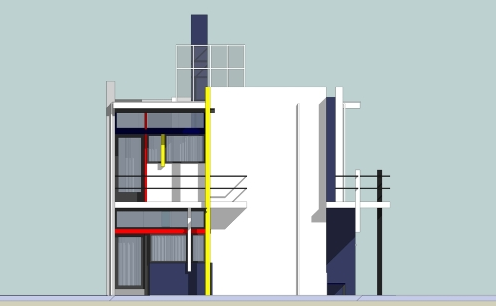During the module, Informing Contexts, I have been increasingly conscious of influences on my image making work. Here is a short study of the work of the early Twentieth Century and an art and architecture movement that has shaped my practice.

figure 1
I have written about minimalism and its influence on my work. I talk practically about reduction, distillation and expressing the essence. It is about images which show the simplicity or the substance of things seen or implied. The practitioners of the de Stijl movement that are most relevant to my visual work are both Mondrian and Reitveld. Mondrian’s work is well known and has found its way into art collections globally. Dutch for ‘the style’, the movement spanned 1917-1931, the principal proponents advocated pure abstraction and a reduction to the essence of form, colour and line; the ‘structure of the three dimensional work, architecture and art is defined by the black line, sharply contrasting with the dominant white backgrounds and the insertion of blocks of signal colours. The transaction of the defined lines and blocks of colour in sculpture and architecture led to planes that were unobstructed by each other. To my mind this led to a richness of depth. The architect Rietveld created the Schröder House (1923/4) in Utrecht for an enlightened client, an icon of the movement and which I have visited. See figure 1.
The most overt example of the influence in my ‘photographer’s eye’ is the image I created from the outside of St Thomas More’s catholic church in East Birmingham in March 2017. Figure 2. The image has planes, lines at horizontal and vertical, blocks of colour defined by sharp shadows and depth.

figure 2
I have undertaken a simple planar image analysis of the formation of lines, the homogenous block colour/tones, including the block of yellow which represents the image’s most conspicuous focal point, the priest.
The original image is shown below.
In undertaking this analysis it has assisted me in slicing the image into its several parts which appear, nevertheless, to be a cogent whole, as does a Mondrian painting. What I also note from the particular painting I use as my primary reference is that the canvas has effectively a frameless ‘edge’ which is echoed in my study as I have have allowed the black ‘construction’ lines to spread beyond the frame that I chose for the image, to imply the ‘beyond’. http://www.tate.org.uk/art/artists/piet-mondrian-1651 figure 3

figure 3
